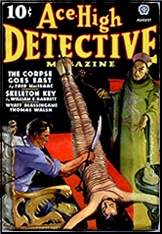REVIEWED BY DAVID VINEYARD:
JOHN CREASEY – Sons of Satan. Dr. Palfrey #11 (*). John Long, UK, hardcover, 1947. Arrow, UK, 1963, as Palfrey versus Sons of Satan (on cover). House of Stratus Ltd, UK, softcover, 2015, as The Sons of Satan. No US edition.

Brett’s (the Marquis of Brett) dream had been of a world united and fighting only the battles of want and disease. Into this man’s mind had first sprung the belief that unity could be fashioned out of the holocaust of the Second World War. So, during the war, he had brought together men of most countries all prepared to sacrifice loyalty to their country to loyalty to the world. Among these men, Palfrey, Bruton and Stefan Andromovitch had been prominent.
For nearly a year now Palfrey had devoted himself solely to working for Brett. Moscow had sent Stefan for the same task, and held others in reserve; Bruton was there with authority from Washington, for most of the nations of the world still subscribed to this world-wide Secret Service.
The mission statement for Dr. Septimus Palfrey and Z5, the worldwide secret service he will soon command, as stated in one of Palfrey’s earliest adventures. The Sons of Satan is the eleventh novel in the thirty-four volume series that is notable for expressing Creasey’s Post-War political views and being his deepest venture into science fiction, if only the kind found in thrillers.

This one opens with Bruce Mallen, an expatriate Brit returning from South America encountering the beautiful Lady Veronica Howell, who slips a strange object into his luggage to be smuggled into England. Soon Mallen has encountered the mysterious and wealthy Colonel George Wray who is tied to Lady Veronica and finds himself a suspected agent of something and someone called Abba and is soon confronted by Z5 agent Stefan Andromovich and Dr. “Sap†(Septimus Alexander) Palfrey himself.
As in the earlier Gordon Craigie series, the Palfrey series often introduces an “innocent†protagonist or one of Palfrey’s agents who only appear in the single book. Here, Mallen, who proves a capable protagonist, finds himself over his head caught between Z5 and the dangerous Abba.
Abba had been a code-word first discovered when a little group of reactionaries had been found in Haifa a few months earlier – neither Jews nor Arabs, but fostering unrest among the races. By devious means they had discovered that Abba was a code-word used elsewhere also; in Trieste for a while, in Milan, in Warsaw and in Prague. Agents had sent their reports in, and so Abba had become to them as Brett and Palfrey were to the world at large – a legendary figure. Who he was, exactly what he was trying to do, they did not yet know. They did know that he worked mostly through religious factions, creating fanaticism out of fervour and madness out of piety.

These megalomaniacal madmen willing to kill millions to achieve their goals remain a staple of the Palfrey adventures rather than spies or agents of other nations. In Dark Harvest, the tenth book in the series, Palfrey and his agents had defeated a madman trying to starve the world through famine. That apocalyptic tone would continue and come to dominate the series with Palfrey battling deadly fogs, world wide forest fires, drought, flood, famine again, infertility, and even alien invasion, surely influencing wirters like John Christopher and J.G. Ballard and possibly even Nigel Kneale’s Quatermass.
Read today in light of the current concerns of climate change the series seems more contemporary than when it was written.
This is the last book to feature the Marquis of Brett as Palfrey’s boss, with Sap soon replacing him as head of Z5, an obvious decision, one that it seems curious it took Creasey eleven books to reach.
Palfrey is a ruthless chief, and agents often sacrifice themselves to the greater good, sometimes at Palfrey’s reluctant but certain order.
Palfrey, Mallen, and Lady Veronica track Abba to his lair in San Palino in Spain, in the Monastery of Azzen where Abba and his Golden Friars spread their religion of hate.
“There are rumours that the order is active in other countries, but that this is its centre and its heart. I hear stories of the spread of this new religion and new worship, and I have seen some of the effect upon the people. Señor, they are good people, but something is turning them bad. Here in the city there is no longer real kindliness or goodwill, they are replaced by suspicion and mistrust. And those who will not subscribe to the new faith – what will happen to them I do not know. I am reminded of the days of Rome, of the arena, of sacrifice to the beasts of the Devil…â€
The Palfrey books are formulaic, so you would not want to read many in a row. There is a mystery that gradually grows more horrible in its implications, the embattled agents of Z5 seem outnumbered and powerless, Palfrey doubts himself and almost gives up, and then at the last moment saves himself and the world, but not without consequence to his agents, the world, and his own conscience.
Readers tend to either love or hate the Palfrey series, and admittedly they can show the best and the worst of Creasey as a writer with Palfrey far less attractive than the Baron, the Toff, Roger West, or George Gideon, but I have a soft place for this very pulp-like series and I suppose a taste for apocalypse, at least fictional ones.
Sons of Satan is an early example of Palfrey at his best.
—
(*) Editor’s Note: Different sources count this as either #9 pr #10, as well as #11.

